Path Difference & Coherence (AQA A Level Physics): Revision Note
Exam code: 7408
Path Difference & Coherence
Superposition and Interference
When two or more waves arrive at the same point and overlap, their amplitudes combine
This is called superposition
The principle of superposition states that:
When two or more waves overlap at a point, the displacement at that point is equal to the sum of the displacements of the individual waves
The superposition of surface water waves shows the effect of this overlap
There are areas of zero displacement, where the water is flat
There are areas of increased displacement, where the water waves are higher
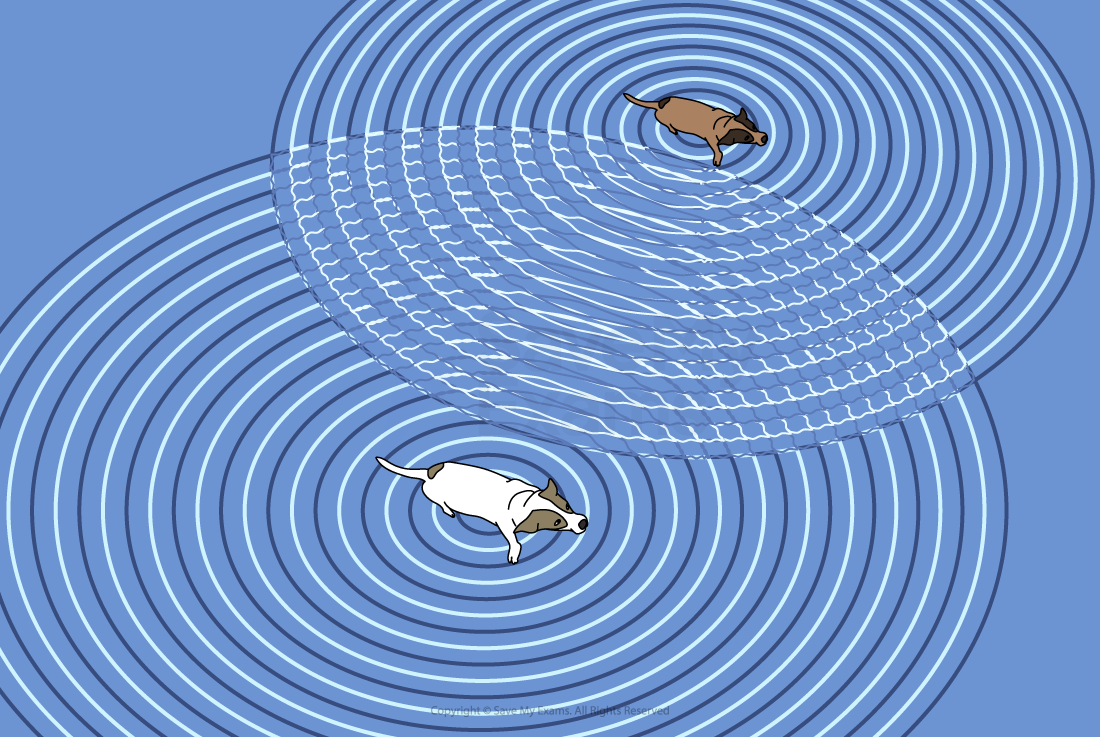
The dogs make waves in the water which superimpose to give areas of both zero and increased displacement.
It is possible to analyse superposition clearly when the waves are drawn on a vertical displacement (amplitude)-displacement graph

Waves can superimpose so their amplitudes are added together often creating a larger resultant amplitude
Interference is the effect of this superposition
Interference can be seen clearly when waves overlap in phase or antiphase
When two waves are in antiphase, their combined effect means they cancel each other out
This is known as destructive interference
When two waves are in phase, their combined effect makes the resultant wave amplitude larger
This is known as constructive interference.

At points where two waves are neither in phase nor in antiphase, the resultant amplitude is somewhere in between the two extremes
Individual wave displacements may be positive or negative and are combined in the same way as other vector quantities
Coherence
For waves to undergo constructive and destructive interference, they must be coherent
Coherence occurs when waves have:
The same frequency
A constant phase difference

Coherent vs. non-coherent waves. The abrupt change in phase creates an inconsistent phase difference.
Examples of interference from coherent light sources are:
Monochromatic laser light
Sound waves from two nearby speakers emitting sound of the same frequency
Path Difference
Path difference is defined as:
The difference in distance travelled by the two waves from their sources to the point where they meet
Path difference vs phase difference
Path difference compares the amount of progress made by waves along a path
Phase difference compares the distance between the phases (peaks and troughs) of coherent waves that are normally travelling parallel to each other at a point
The path difference between two coherent waves determines whether there is constructive or destructive interference where they meet
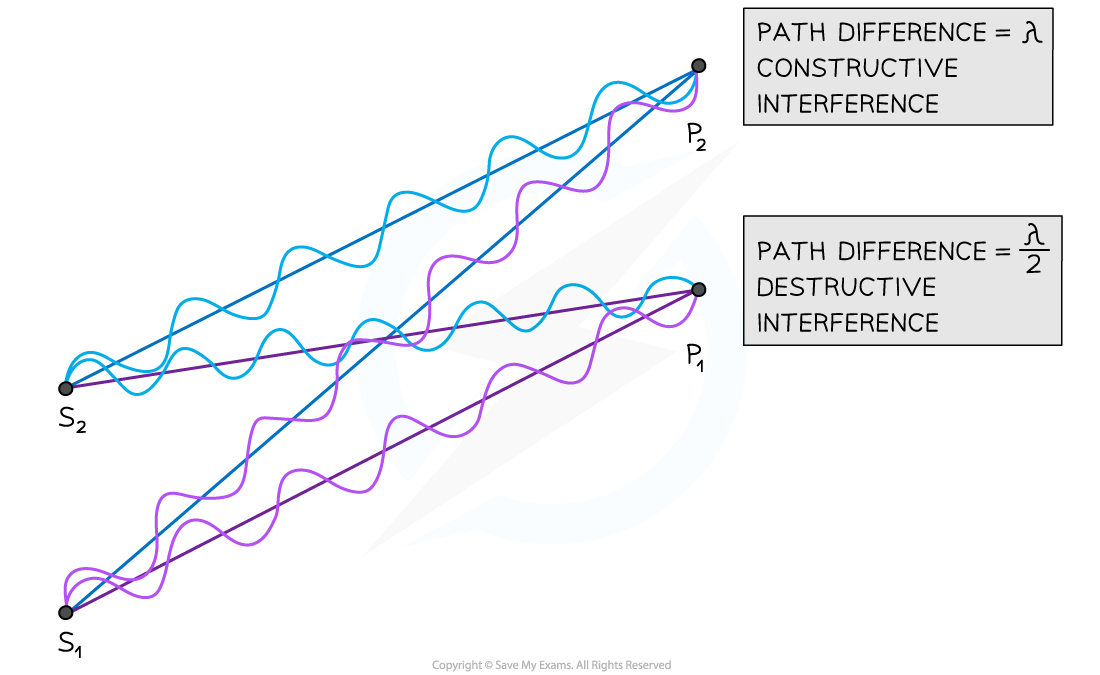
At point P2 the waves from S1 and S2 have a path difference of a whole number of wavelengths resulting in constructive interference. At point P1 the waves have a path difference of an odd number of half wavelengths resulting in destructive interference
Path difference is generally expressed in multiples of wavelength
Remember to count a whole number of wavelengths (the wave should go up, down, and then back to where it started in one wavelength)
In the diagram above, the number of wavelengths between:
S1 ➜ P1 = 6λ
S2 ➜ P1 = 6.5λ
S1 ➜ P2 = 7λ
S2 ➜ P2 = 6λ
The path difference at point P1 is 6.5λ – 6λ = λ / 2
The path difference at point P2 is 7λ – 6λ = λ
Conditions for Constructive and Destructive Interference
In general, for waves emitted by two coherent sources very close together:
The condition for constructive interference is:
path difference =
The condition for destructive interference is:
path difference =
Where:
λ = wavelength of the waves in metres (m)
n = 0, 1, 2, 3... (any other integer)
Wavefront Diagrams
Wave behaviour can also be shown by a wavefront diagram
A curved line represents each wavefront (peak or trough)
This can show the interference between waves more clearly
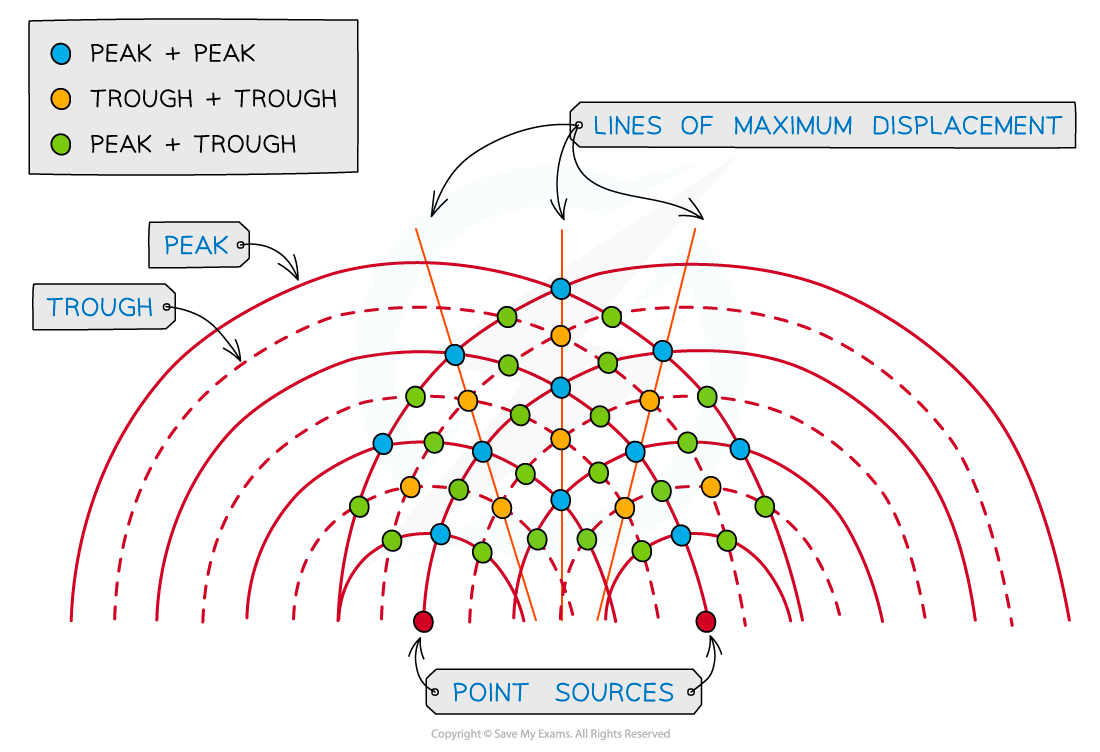
At the blue dot where the peak of two waves meet, constructive interference occurs. At the yellow dot where two troughs meet, constructive interference also occurs. Constructive interference occurs along the lines of maximum displacement. At the green dot, where a peak and a trough meet, destructive interference occurs
On a wavefront diagram, it is possible to count the number of wavelengths to determine whether constructive or destructive interference occurs at a certain point
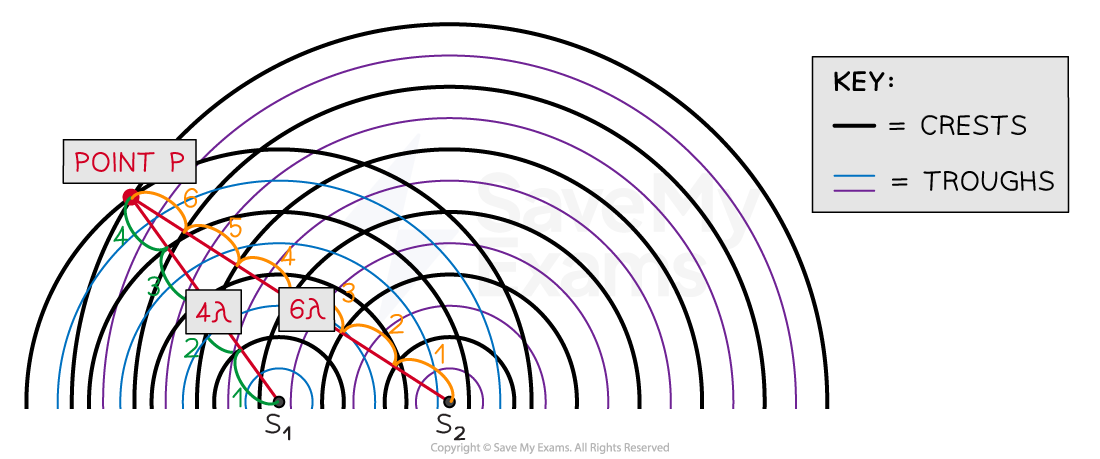
At point P the waves from S1 and S2 have a path difference of a whole number of wavelengths, resulting in constructive interference
At point P, the number of crests from:
Source S1 = 4λ
Source S2 = 6λ
So the path difference at P is 6λ – 4λ = 2λ
This is a whole number of wavelengths, hence, constructive interference occurs at point P
Worked Example
The diagram shows the interferences of coherent waves from two-point sources. All waves start oscillating from their equilibrium position.

Which row in the table correctly identifies the type of interference at points X, Y and Z.
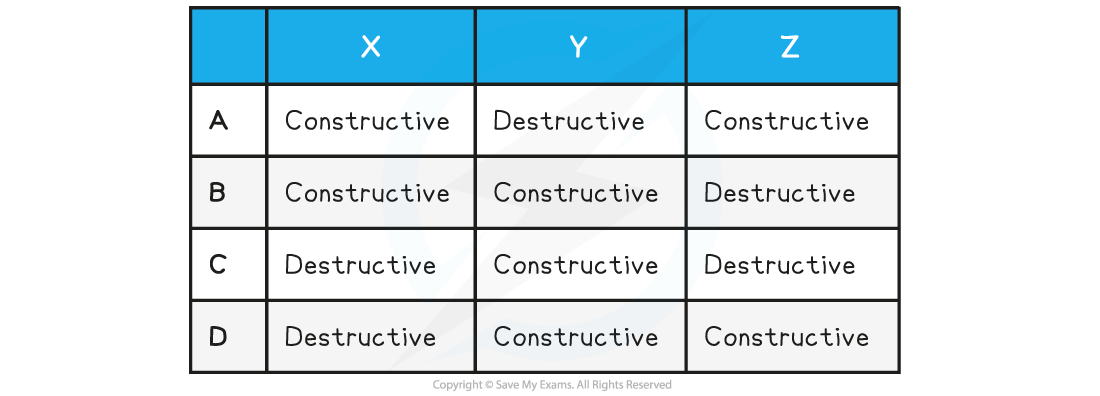
Answer: B
At point X:
Both peaks of the waves are overlapping
Path difference = 5.5λ – 4.5λ = λ
This is constructive interference and rules out options C and D
At point Y:
Both troughs are overlapping
Path difference = 3.75λ – 3.75λ = 0
Therefore constructive interference occurs
At point Z:
A peak of one of the waves meets the trough of the other
Path difference = 4λ – 3.5λ = λ / 2
This is destructive interference
Examiner Tips and Tricks
Remember, the interference of two waves can be either:
In phase, causing constructive interference. The peaks and troughs line up on both waves. The resultant wave has double the amplitude
In antiphase, causing destructive interference. The peaks on one wave line up with the troughs of the other. The resultant wave has no amplitude
Think of ‘constructive’ interference as ‘building’ the wave and ‘destructive’ interference as ‘destroying’ the wave.
Make sure you understand that a path difference is the difference between the length of the two paths, and not the distance between the two paths.

Unlock more, it's free!
Did this page help you?